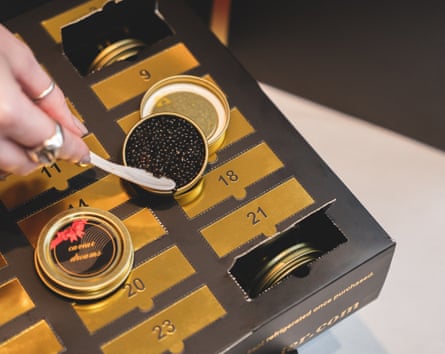The satisfaction of an advent calendar used to come from winning an argument with your siblings over whose turn it was to peel back a tiny cardboard door to reveal a Christmassy image. In the 1990s, chocolate calendars began to appear more widely on UK supermarket shelves, a trend that migrated from the US. However, anyone who wasn’t allowed sweets before school had to make do with a card version, often reused, its doors growing more and more unhinged each December.
Then, in 2010, Selfridges launched a beauty calendar, and the countdown to Christmas fundamentally changed. A gorgeous box with 24 sliding doors, each housing a miniature beauty product from a range of luxury brands, it set a new standard in British advent calendars – and a new price point. The original cost £60, but this year’s version was £220. It sold out in September.

Less nativity-themed and more commercial, these elaborate calendars for adults have now become the norm. Liberty’s own take on an advent calendar, which it launched in 2013, remains the fastest-selling product in the store’s 150-year history, with one calendar selling every two minutes. This year’s £250 edition sold out within days.
Name the brand and you’ll find the corresponding calendar. Porsche (£100) lets car fans build their own mini model of a 911 Carrera by unboxing one piece a day. Each of Wedgwood’s 24 doors on its £860 calendar contains a mini porcelain ornament to hang on the tree, while for connoisseurs of caviar, Caviar House & Prunier sells a £350 calendar with 24 tins of fish eggs. MyProtein’s take includes 24 different protein bars alongside a daily fitness challenge such as squat jumps, while Ann Summers has a range of “adult” calendars which promise to “put the flirty fun in the festive season” with daily boxes containing bondage toys and vibrators. At the bleaker end of the spectrum, Vitality CBD offers 12 days of disposable vapes, while Fortnum and Mason sell spenny yet empty calendars, instead encouraging customers to fill their own.

The proliferation of advent calendars coincides with a corresponding emergence of “little treat” culture. Rife on social media, it encourages users to post about rewarding themselves for doing something. Daily walks are followed by a nice coffee. A day in the office calls for a fancy salad at lunchtime.
All this harks back to the lipstick effect, coined by Estée Lauder co-founder Leonard Lauder during the Great Depression of 1929. Lauder observed that during economic upheaval, people rein in big spending but are more likely to allot a modest amount of money on small indulgences such a red lipstick. His theory was once again proved right during the 90s dotcom crash and the 2008 recession. Earlier this year, John Lewis said it was experiencing a “moments economy” with a spike in sales of mini candles, lip oils and sheet face masks.
So, on a cold and dark morning, what better way to lure yourself out of bed than with a surprise luxury beauty product or a tiny tin of fish eggs? Or perhaps some whey protein powder is more your speed. Nothing says festive spirit quite like it.
after newsletter promotion
To read the complete version of this newsletter – complete with this week’s trending topics in The Measure and your wardrobe dilemmas solved – subscribe to receive Fashion Statement in your inbox every Thursday.
